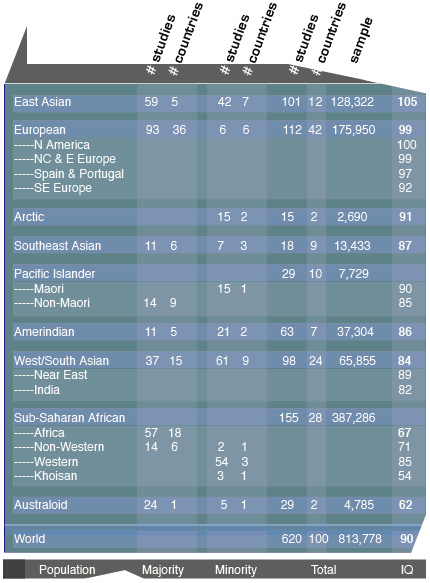IQ by Gender and Race: An Appeal to End the Practise of Brainbinding
 We begin with a study comparing "g" of males and females, from 100,000 SAT scores. This article will appear in "Intelligence" and is reported by Dienekes Anthropology Blog. The following is the study abstract:
We begin with a study comparing "g" of males and females, from 100,000 SAT scores. This article will appear in "Intelligence" and is reported by Dienekes Anthropology Blog. The following is the study abstract:In this study we found that 17- to 18-year old males averaged 3.63 IQ points higher than did their female counterparts on the 1991 Scholastic Assessment Test (SAT). We analysed 145 item responses from 46,509 males and 56,007 females (total N = 102,516) using a principal components procedure. We found (1) the g factor underlies both the SAT Verbal (SAT-V) and the SAT Mathematics (SAT-M) scales with the congruence between these components greater than 0.90; (2) the g components predict undergraduate grades better than do the traditionally used SAT-V and SAT-M scales; (3) the male and the female g factors are congruent in excess of .99; (4) male–female differences in g have a point-biserial effect size of 0.12 favoring males (equivalent to 3.63 IQ points); (5) male–female differences in g are present throughout the entire distribution of scores; (6) male–female differences in g are found at every socioeconomic level; and (7) male–female differences in g are found across several ethnic groups. We conclude that while the magnitude of the male–female difference in g is not large, it is real and non-trivial. Finally, we discuss some remaining sex-difference/brain-size/IQ anomalies. Source.
This is not significant, societally, although it is consistent with Lynn's and other researchers' previous results, inconsistent with others, and very politically incorrect. Individuals do not follow statistical distributions and should not be judged by them. You should notice the difference in this distribution from population distributions, due to selection from the pool of SAT takers, rather than the general population.
 The second part of this posting deals with Lynn's new book, Race Differences in Intelligence. This comes courtesy of iSteve.com, and Sailer's article discussing the book is worth reading. After discussing Lynn and Vanhannen's IQ and the Wealth of Nations, Sailer moves to Lynn's new book:
The second part of this posting deals with Lynn's new book, Race Differences in Intelligence. This comes courtesy of iSteve.com, and Sailer's article discussing the book is worth reading. After discussing Lynn and Vanhannen's IQ and the Wealth of Nations, Sailer moves to Lynn's new book:Now, Lynn has a new book out, Race Differences in Intelligence, which tabulates 620 separate studies of average IQ from 100 different countries with a total sample size of 813,778. That's nearly four times the number of studies summarized in his book with Vanhanen. (Here is J.P. Rushton's review on VDARE.com, and here is Jason Malloy's review on GNXP.com.)
This profusion of data allows us to do analyses of important issues that haven't been feasible before.
Source. Be sure to read James C. Bennett's reply and objections at the source above. There are places on the net where discussions are freewheeling and relatively unrestricted, as long as you are civil and intelligent. If there is anything to Lynn's theory of "IQ and the Wealth of Nations," immigration policy planners might reconsider their policies.
 You see what I mean about not politically correct? Most conventionally educated students and graduates are not prepared for anything so far out of the mainstream. Just like the ancient Chinese tradition of footbinding, the brains of modern students are bound by politcally correct restrictions on what they can read and discuss. How uncomfortable for them, then, when the cognitive dissonance of the real world sets in. Brainbinding--what a comfort, eh? How much better to confront the student with the ideas in all their wickedness, and discuss them honestly to the best of scientific knowledge--understanding that science does not stand still?
You see what I mean about not politically correct? Most conventionally educated students and graduates are not prepared for anything so far out of the mainstream. Just like the ancient Chinese tradition of footbinding, the brains of modern students are bound by politcally correct restrictions on what they can read and discuss. How uncomfortable for them, then, when the cognitive dissonance of the real world sets in. Brainbinding--what a comfort, eh? How much better to confront the student with the ideas in all their wickedness, and discuss them honestly to the best of scientific knowledge--understanding that science does not stand still?The professors are themselves victims of brainbinding, often self-inflicted. Universities should be places where minds are unbound, and introduced to the complex inter-dynamics of a broad range of ideas. That is presently a lost ideal, but one worth pursuing.
Labels: IQ, women and math

0 Comments:
Post a Comment
“During times of universal deceit, telling the truth becomes a revolutionary act” _George Orwell
<< Home